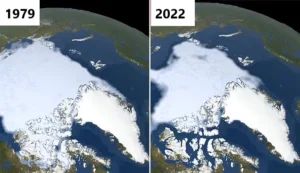The data from NASA’s satellite observations in September 2023 revealed concerning trends in both the Arctic and Antarctic regions. The Arctic experienced its sixth-lowest minimum ice extent on record, while the Antarctic saw its smallest maximum ice coverage ever recorded. These findings are consistent with the ongoing trend of declining ice coverage in both polar regions.
The Arctic, in particular, has been experiencing a steady decrease in sea ice since NASA began satellite observations in 1978. Projections suggest that the Arctic could potentially face ice-free conditions in September by the 2020s or 2030s, meaning there would be less than a million square kilometers of ice coverage. Even during the minimum ice extent of 2023, Arctic sea ice covered 1.63 million square miles or 4.23 million square kilometers.

Predictions indicate that by the 2030s, summer ice in the Arctic could shrink to about 24 percent of its 2023 size, regardless of emission scenarios. Scientists expect this decline to continue, with ice-free conditions becoming more frequent in the Arctic by 2067, extending beyond just September to include August and October. However, reducing greenhouse gas emissions could delay this milestone.
The study, published in Nature Reviews Earth & Environment, underscores the urgent need for emission reduction efforts. Lead author Alexandra Jahn emphasizes that even inevitable ice-free conditions require minimizing emissions to prevent prolonged ice-free periods. These projections have significant consequences for wildlife relying on sea ice, such as polar bears, which face increasing challenges as their habitat shrinks.
The melting Arctic ice also has broader implications, including easier navigation routes for shipping, potentially benefiting commercial interests but posing new challenges for marine mammals like blue whales. Additionally, melting Arctic ice exacerbates global warming by reducing the earth’s albedo effect. Less ice cover means less reflective surface to bounce sunlight back into space, accelerating melting and amplifying oceanic heat absorption. This feedback loop intensifies the frequency and severity of heat waves, perpetuating a cycle of warming and melting.
Despite these alarming projections, there is hope in the Arctic’s ability to respond to climate change. Unlike long-term geological processes such as glacier formation, Arctic sea ice can regenerate relatively quickly if emissions are reduced. This highlights the importance of swift action to mitigate climate change and protect the Arctic’s ecological balance.





